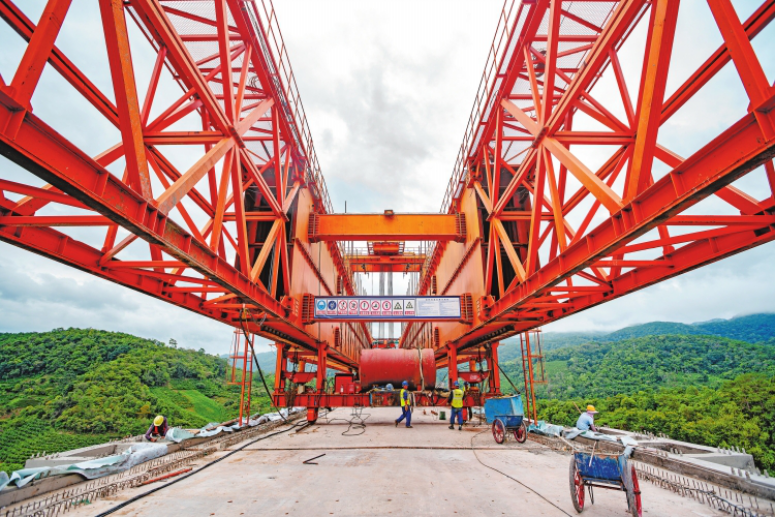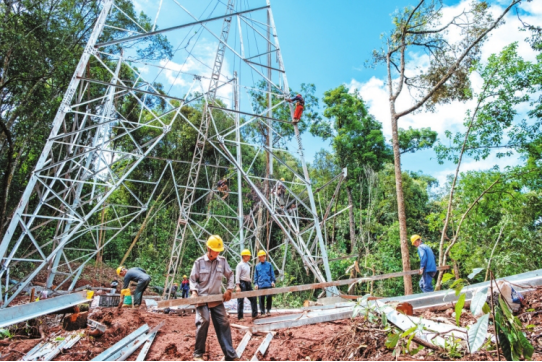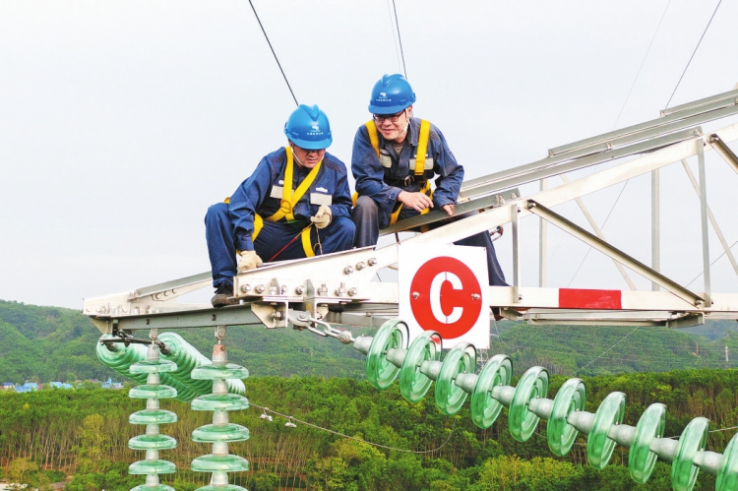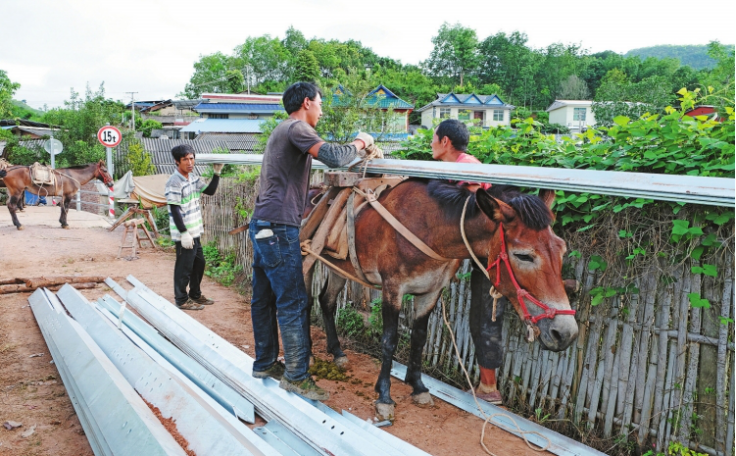from:China Southern Power Griddate:2021-01-10

The External Power Supply Project of the Laos Section of the China-Laos Railway Completed
In September 2019, Yunnan Pu’er Power Supply Bureau, in cooperation with the Railway Department to move and transform a 220-kV transmission line, for which overlapped with the under-construction Munai River Double Track Railway Bridge.

On June 18, 2021, workers were building pylons in the 6th section of the Xishuangbanna section of the China-Laos Railway.

On May 20, workers of the Yunnan Power Transmission and Substation Company examine the pylons of the Project.

During the rainy days in May and June, horses were used for delivering building materials for the 6th section.
Vientiane, Laos - On August 31, the external Power Supply Project of the Laos section was completed and expected to soon be fully operational, which laid a firm foundation for the operation of all lines by the end of this year.
Year 2021 marks the 60th Anniversary since the establishment of diplomatic relations between China and Laos. The China-Laos Railway Project is important linchpin in the alignment of China’s Belt and Road Initiative with the underlining strategy of transforming Laos from a landlocked to a land-linked country. It is also the first external railway Project significantly invested and operated by China which directly connects to China's current Railway Network.
The construction of the China-Laos Railway features the full realization of eco-friendliness, benefit-sharing and win-win cooperation to promote a better life for all people living and working along the Railway as part of the BRI.
One of the hallmarks of the electric railway are its significant green and low-carbon elements that will evolve into a more “plus” development in this Century. Among them, the external power supply Project of the China-Laos Railway, invested by China Southern Power Grid, is an important power road that offers multiple “plus” developments.
“The ‘plus’ represents environmental protections that we have adopted which include the latest technologies to reduce environmental damage. The ‘plus’ also represents sharing, referring to that we cultivate a host of talents in power industry for Laos to drive local employment and ensure abundant power supplies,” said Zhong Xiaotao, Senior Manager of the International Cooperation Department of CSG.
Key program elements of the Laos section of the China-Laos Railway include 936-km power lines and 2,220 pylons with more than half of lines running through treacherous mountainous regions. The Railway has been divided into two sections - China and Laos respectively – that have been invested, built and operated by China Southern Power Grid and the China-Laos Power Investment Company, a joint venture by CSG Yunnan International Co., Ltd. and Électricité du Laos.
Électricité du Laos is the state corporation of Laos that owns and operates the country's electricity generation, electricity transmission and electricity distribution assets.
The Project used various full-fledged technologies to protect and respect the local environment and eco-systems. To build the necessary pylons, the top of a mountain might be flattened. But now by using pylons with legs of different height, the length of the four legs are then determined according to the mountain terrain and only four points need to be built to minimize damage to the surrounding vegetation.
After construction, CSG engineers purchased and sowed seeds to recover the previous ecosystem vegetation. Now the pylons are higher than before, rising from 30 to 40 meters to 60 to 80 meters which diminishes the damage to surrounding vegetation and maintains migratory channels for animals.
“Lucid waters and lush mountains are invaluable assets. It also applies to many areas in Laos,” said Huang Wengang, President of the China-Laos Power Investment Company and manager of the Project.
“In Laos, the salary of a skilled worker is twice that of a common worker. If you want to earn more income, you need to be skillful." said Aipian, a staff member from Laos and team leader of the second section of the Project.”
He added, “In this Project, I learned many skills such as pylon building, inspection and acceptance and power lines erecting, which will help me to be more competitive in applying for other Projects.”
The China-Laos Railway will make significant contributions to business developments along the Railway and is expected to lead to increased local power consumption … which in turn will ensure consistent power supply flow.
Apart from an enhanced main grid, the pool of available local “human” power talents is also important.
“We hope to provide new job opportunities and advantages for our employees, and to reserve skillful talents for the construction of Laos power grid in the future,” said Mr. Huang.
During the construction of the Project, many Chinese senior managers and CSG staff developed deep friendships with their Laos apprentices.
The construction of the Project has also significantly improved transportation in the mountainous areas of northern Laos. In addition to the construction of builders’ roads, the Project has extended new infrastructure to numerous villages along the line, making it easier for residents to transport agricultural and pasture products out of the mountains via small farm vehicles, instead of being carried by people or by horseback.
Musai lives in Hui Pian village in Muang Xay, Oudomxay Province, Laos. He explained that, “there was only one narrow road into the village and it always turns muddy in rainy days. Now with the wide gravel road, we can drive our tractors and transport rice to Muang Xay for sales. It is very convenient.”
Wankan lives in the same village and looks forward to driving his beef castles to Meuang Nga Station of China-Laos Railway near his hometown and then traveling north along the new railway to sell them in China.
The China-Laos Railway has already manifest itself into offering a better life for local residents with the support of CSG. The Project along the China section of the Railway is in the planning stages of the Yunnan Power Grid Construction Company for the next decade.
“In Laos, we, together with Électricité du Laos, will improve reliability of the power supply of the China-Laos Railway, and do our best to guarantee power supplies of the Railway. We pledge to work with all parties to build the path of prosperity,” said Yang Ronghui, Board Chairman of the China-Laos Power Investment Company.
When fully operational by the end of 2021, the China-Laos Railway will create huge business opportunities to facilitate local economic and social development.
“With the railway, we have convenient transportation and brand new opportunities for trading. Our food stuffs will surely sell well and our families will now be able to travel to China by train as all of our lives continue to get better,” said Musai.
Like Musai and Wankan, the Laos people along the line look forward to a better life with the China-Laos Railway.
Tel:+86-25-84152563
Fax:+86-25-52146294
Email:export@hbtianrui.com
Address:Head Office: No.8 Chuangye Avenue, Economic Development Zone, Tianmen City, Hubei Province, China (Zip Code: 431700) Nanjing Office: Room 201-301, Building K10,15 Wanshou Road,Nanjing Area, China (Jiangsu) Pilot Free Trade Zone,Jiangsu Province,China (Zip Code:211899)
